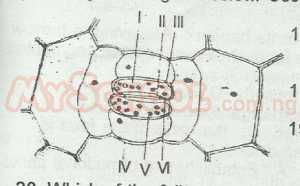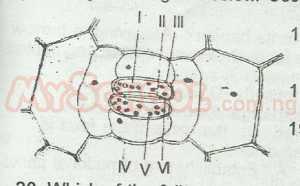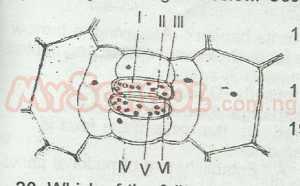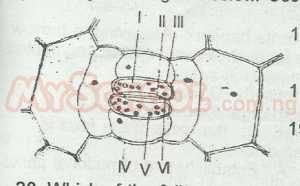Year :
2000
Title :
Biology
Exam :
WASSCE/WAEC MAY/JUNE
Paper 1 | Objectives
11 - 20 of 60 Questions
| # | Question | Ans |
|---|---|---|
| 11. |
The following are the functions of supporting tissues in plant except A. rigidity B. flexibility C. strengthening D. secretory |
D |
| 12. |
Which of the following organisms has the largest surface area-to-volume ratio? A. Man B. Earthworm C. Amoeba D. Grasshopper |
C |
| 13. |
Which of the following plant parts does not perform supportive function? A. Parenchyma, xylem and B. Epidermis, sclerenchyma and xylem C. Parenchyma, collenchyma and sclerenchyma D. Sclerenchyma, xylem and collenchyma |
B |
| 14. |
The following are useful effect of micro-organisms except A. production of vaccines B. curing of tobacco C. tanning of leather D. decay of meat |
D |
| 15. |
Which of the following structures is not present in the vascular bundles of a dicot stem? A. Xylem B. Phloem C. lntra-fascicular cambium D. Inter-fascicular cambium |
C |
| 16. |
When a mammal respires anaerobically for a long time A. pyruvic acid is convened into acetyl COA B. more energy is released from fats in the body C. lactic acid accumulates in the muscles D. the Krebs cycle is fully completed. |
B |
| 17. |
 Which of the labelled structures in the diagram are involved with the entry A. I, II and III only B. I, II, III and VI C. I, II, V and VI D. I, II, III, and IV |
B |
| 18. |
 Which of the labelled structures in the diagram will shrink when plasmolysis A. I B. II C. III D. IV |
A |
| 19. |
 The condition shown in the above diagram is due to A. conversion of starch to sugar B. conversion of sugar to starch C. excess water in structure labelled I D. presence of carbondioxide in the structure labelled I |
C |
| 20. |
 Which of the following solutions will induce the condition shown in the diagram? A. Hypertonic solution B. Hypotonic solution C. isotonic solution D. Distilled water. |
B |
| 11. |
The following are the functions of supporting tissues in plant except A. rigidity B. flexibility C. strengthening D. secretory |
D |
| 12. |
Which of the following organisms has the largest surface area-to-volume ratio? A. Man B. Earthworm C. Amoeba D. Grasshopper |
C |
| 13. |
Which of the following plant parts does not perform supportive function? A. Parenchyma, xylem and B. Epidermis, sclerenchyma and xylem C. Parenchyma, collenchyma and sclerenchyma D. Sclerenchyma, xylem and collenchyma |
B |
| 14. |
The following are useful effect of micro-organisms except A. production of vaccines B. curing of tobacco C. tanning of leather D. decay of meat |
D |
| 15. |
Which of the following structures is not present in the vascular bundles of a dicot stem? A. Xylem B. Phloem C. lntra-fascicular cambium D. Inter-fascicular cambium |
C |
| 16. |
When a mammal respires anaerobically for a long time A. pyruvic acid is convened into acetyl COA B. more energy is released from fats in the body C. lactic acid accumulates in the muscles D. the Krebs cycle is fully completed. |
B |
| 17. |
 Which of the labelled structures in the diagram are involved with the entry A. I, II and III only B. I, II, III and VI C. I, II, V and VI D. I, II, III, and IV |
B |
| 18. |
 Which of the labelled structures in the diagram will shrink when plasmolysis A. I B. II C. III D. IV |
A |
| 19. |
 The condition shown in the above diagram is due to A. conversion of starch to sugar B. conversion of sugar to starch C. excess water in structure labelled I D. presence of carbondioxide in the structure labelled I |
C |
| 20. |
 Which of the following solutions will induce the condition shown in the diagram? A. Hypertonic solution B. Hypotonic solution C. isotonic solution D. Distilled water. |
B |